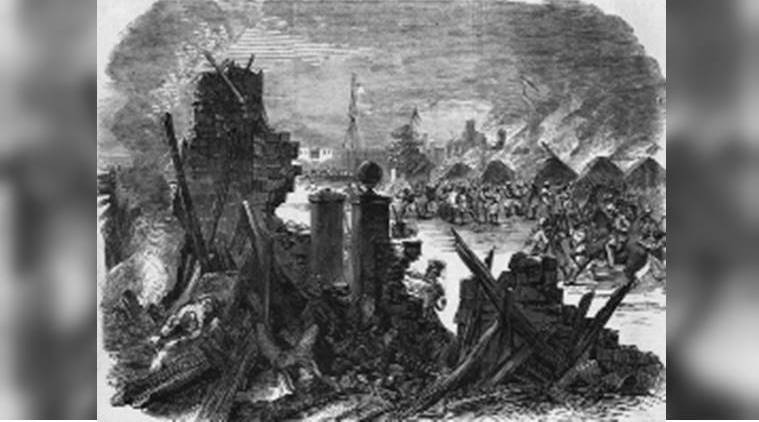 Shots fired: The ardh satya of the First War of Independence. (Source: Wikimedia Commons)
Shots fired: The ardh satya of the First War of Independence. (Source: Wikimedia Commons)
Back in school, we were taught that the rising of 1857 was sparked off by a rumour that the new Enfield Pattern 1853 rifle-musket issued to the sepoys of the East India Company came with a cartridge dipped in beef and pork fat, which made it anathema to both Hindu and Muslim sepoys, who had to bite open the cartridge to load the weapon. It wasn’t just the school books. Even contemporary accounts and fairly learned studies of the events of 1857 report this as a rumour, and some speculate that it was circulated by the wily gentlemen of Awadh in the hope of recovering their fortunes.
It was all quite mysterious, because we had seen cartridges in Westerns, metal-jacketed objects that no one could possibly bite without losing their teeth. Apparently, some mysteriously chapatis were also involved in the matter. The mobile bread must remain unexplained, but a slim volume titled Instruction of Musketry, which was a standard training manual of the English infantry at the time of the Indian rising and the Crimean War, makes it clear that the story about the cartridge was no rumour. It was half the truth — ardh satya, a fairly common feature of Indian history.
Fears of inadvertent religious transgression was one of the sources of the rising, along with rumours about conversion and anger about high land taxes and changes in the fortunes of sepoys, but there seems to be no agreement on whether the anxiety about the new cartridges was real, or the fruit of a whisper campaign. But the training manual clarifies that Hindu sepoys had reason to fear, but their Muslim brothers in arms were needlessly agitated.
Let’s begin at the beginning. About the time of the Crimean War, the British army phased out the doughty old Brown Bess musket in favour of the Enfield Pattern 1853, or P53 for short. The old veteran was a smoothbore muzzle-loader, and the ball tended to tumble in flight. It was inaccurate at long ranges. The Enfield which replaced it was a muzzle-loader, too, but it had a rifled barrel which imparted spin to the bullet. The law of conservation of angular momentum, which has been known to armourers from the time of longbows, kept it true to a range of a mile and a quarter. Designed at the Royal Small Arms Factory in the London borough of Enfield, the rifle-musket was sold to the East India Company by Parker, Field & Sons of High Holborn.
The P53 was a kind of halfway house, half a generation ahead of a musket but not a modern breech-loading rifle, where you lever a cartridge into the breech, shoot the bolt home and blaze away mercilessly. There is no need to bite a modern cartridge, which is a projectile atop a charge of gunpowder and a percussion cap, all packaged together. The P53 cartridge was also a package, but a Minie cartridge, innovated in France by Claude-Étienne Minié. The rifleman had to tear it open, pour the powder down the barrel and ram the bullet home after it. Since he had the rifle in one hand and the cartridge in the other, the only way to open it was with the teeth. YouTube has some videos of modern replicas of the weapon being loaded and fired, and you can clearly see why the marksman has to bite off the end of the cartridge.
Now, back to the textbook, Instruction of Musketry. The 1856 edition, which caused all the trouble in Barrackpore and Meerut, is available only in hard copy in the US and all but inaccessible to us. But the 1855 edition, scanned from a copy at the University of Oxford, is online. Published for the Military Library, Whitehall, by Parker, Furnivall and Parker, almost all of its 63 pages are deathly boring for the majority, who are disinterested in the intricacies of leaf sights, windage and volley firing by rank. The interesting section concerns the manufacture of cartridges, which were to be fabricated by the soldiers themselves, making up a tubular package of the Minie bullet and “two and a half drams of fine powder”. The final instruction was to waterproof the cartridge: ‘When completed, the base of the cartridge must be dipped up to the shoulder of the bullet in a pot of grease, consisting of six parts tallow to one of bee’s wax.”
There it is: at the time, “tallow” signified rendered bovine fat. There is no mention of lard, which was rendered pork fat. These meanings were specific at the time, before hydrogenated fats entered the market and, clearly, Muslim sepoys were in no danger at all. But their Hindu colleagues were very much at risk, and they were willing to fight for the restoration of the Mughal empire to save themselves embarrassment. Fortunately, the Hindu-Muslim divide had not been politically sharpened, as it is today, or about half of the sepoys would have considered it anti-national to rebel to bring a Mughal emperor back to the throne of Delhi. Even if it meant running the gauntlet of the tallow on those Pattern 1853 cartridges.